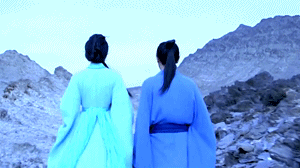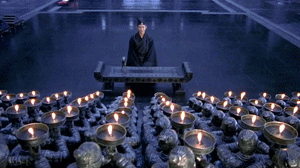







“A dead man begs you to remember; a warrior’s ultimate act is to lay down his sword.”
Hero (2002) dir. Zhang Yimou is a cerebral experience that stops at the retina. It is rapturously beautiful, enchanting in its colours, and it’s a film that has grace. When the characters don’t speak, their swords do. And when nothing else on screen makes a sound, the music does. A martial arts Fant-Asia costume epic, it encompasses every aspect cinema was made for – sweeping imagery, an unusual narrative, a stirring soundtrack, and heartbreaking performances from the leads.
As Hero unfolds, it’s multitude of different accounts of one man’s story is beguiling. The film opens with stunning visuals, intercutting between the frenzy of horses running and the calmness of blue mountains. The storyteller is Nameless, who arrives at the imperial court of the dreaded King of Qin. Nameless tells the tale of how he singlehandedly overcame the three most dangerous assassins in Qin. The narrative tells and retells the story three times differently, each flashback coloured by a separate personal perception.
The following are some points I found that stood out to me the most in the film.
THE RESILIENCE OF CHINESE PEOPLE IN THE FACE OF HARDSHIP AND ADVERSITY
天下 (tian xia) : all under heaven
I saw the Qin army in Hero as a ruthless war machine with no face, no identity, and a kindling for shedding human blood. They were like soldier ants, a black mass, with no individual thoughts or opinions. The Qin army’s unison cry of “Feng! Feng!” is faintly reminiscent of the Nazi salute “Sieg Heil!”
In stark comparison, Nameless, Broken Sword and Flying Snow were resilient in bringing revenge for their fallen kingdom Zhao, seized and destroyed by Qin. The characters were motivated by uniting China, albeit their different personal feelings for killing the king.
In the end, the sacrifice of all three lives of Nameless, Broken Sword and Flying Snow warranted the unity of China, 天下.
STRONG FEMALE CHARACTERS
This is a film where women will fight to the death for what they believe in. In a field where men are traditionally seen on screen in duels, the women in this movie, Flying Snow and Moon, wield their own swords and fight their own battles.
The woman warriors in Hero serve as both a multi-faceted characterisation and a definitive style in 21st century Asian cinema. Equipped with the deadliest martial arts skills in China, Flying Snow and Moon are two very different woman – one who acts on emotions, is bent on unadulterated rage for the king and who kills without thought, and another who is submissive, servile and completely obedient to her master.
The battle between Flying Snow and Moon is an enthralling experience, two beautiful women fighting to their deaths, whirling in a sea of falling leaves. As Moon falls, the leaves fade to blood red, signifying the finality of her death.

COLOURS
While Hero surely features a multitude of memorable elements – captivating performances, stunning fight choreography, gorgeous set pieces, it’s use and understanding of colours are exceptional. A single colour of each episode fills the entire screen, covers each character’s bodies and paints every set. They separate three different accounts of the story told, each colour drawing out a different emotion from the audience.
Zhang claims that there is no link between the story lines and the colours but then, maybe he’s just messing with us.
Red – Wrath

Blue – Imagination

Green – Harmony

White – Passing

Black – Dynasty

The most stunning mise en scène by far is Blue, where red has bled dry and has calmed down for a lake that awaits, as still as a picture. Nothing else around the screen moves except for two warriors that acquire the most dangerous weapon – anger. Blades slice through the water, their warrior yells cut through the mist and it seemed like nothing could stop them but a single drop of water that falls on a lover’s cheek.
CONCLUSION
To conclude, below is a quote I resonate firmly with from the director, Zhang Yimou.
“A few years later, if someone mentions Hero, you are going to remember the colors. You are going to remember in a sea of golden leaves, two ladies dressed in red dancing are in the air. You are going to remember, on a lake as still as a mirror, two men are using their swords to convey their sorrow, like birds flying on the water, like dragonflies.”

I enjoyed your review very much. I just realised that it is true that when the characters are not talking, their swords do. Everything seemed to fall in place in terms of visuals and aesthetics. Also, the point about the Chinese’s resilience in the face of hardship was on point as well. I think that people forget the fact that this is loosely based on real life events, and the unison and prosperity of the Chinese nation does not come by chance. Hero is both at the same time a visual masterpiece, as well as a film rich with culture and history and we should be thankful for Zhang’s creation. Looking forward to your next post!
LikeLike
Stunning visuals that accompanied a well thought out piece of review. I’m sure you’d agree with me that Director Zhang Yimou, Cinematographer Christopher Doyle and their team has done wonderfully in creating such a breathtaking piece. The wuxia (martial arts) genre set during the period of waring states in China is a common one. And it takes a special director and team to take such a spin on a seasoned topic and make it successful at the same time.
I particularly enjoyed your insights on how when the characters are silence, their grace and actions do the speaking and what the set is silence, the music tells the story. This was perhaps why even without dialogue, the film has so successfully weaved its narrative.
Also, i liked how the beginning and the end of the movie were filmed in a monotonous shade, with grey, white and black hues.
All in all, this was a memorable film and the phenomenally artistic visuals would always be deemed as a nonpareil work in asian cinema history.
LikeLike
Visuals and headers in your review are as aesthetically pleasing as the visuals in Hero. Your insight on how silence was accompanied with music made me go back on few scenes to capture the essence. My very first Chinese film, albeit confusing but I can understand better with the major points you have included.
I agree with the characterization of women in this film. It was refreshing to watch a film unfold the prejudices on women and portray them skilful, abled yet majestic beings. The phrase “ruthless war machine with no face, no identity, and a kindling for shedding human blood” describing the Qin army could not have been explained otherwise.
LikeLike
I thoroughly enjoyed your review of this fantastic movie. The images, gifs and videos really brightened up the review, which was already an interesting read to begin with.
I thought it was interesting how you compared the King of Qin to Adolf Hitler. Both were ruthless, ambitious dictators hellbent on conquering the free world. Of course, nobody is the villain in their own story.
During my research for this review, I also chanced upon the interview where Zhang Yimou explains that the colours bear no significance, and are merely in the film as indicators of the different scenes. As I mentioned in my own review, the audience can draw their own meaning from the movie, and I thought it was a nice touch associating an emotion with every colour used.
Spectacular review, and I am in awe of you work as always. Good job, and hope to see more of your work soon!
LikeLike
I don’t think that the colours featured in the film had no meaning. Even if they didn’t, as Zhang claims, some thought were still put into them. I don’t think it’s a coincidence that the version of story where the characters based their decision on their emotions is in red and the true version is in white. Though I have to admit, I did not see pass red, blue and white. Your interpretations of black and green is refreshing indeed.
I wouldn’t go as far as compare Qin with Adolf Hitler though. Qin seemed to be a wise and just emperor unlike hitler who’s known to be a charismatic tyrant.
LikeLike